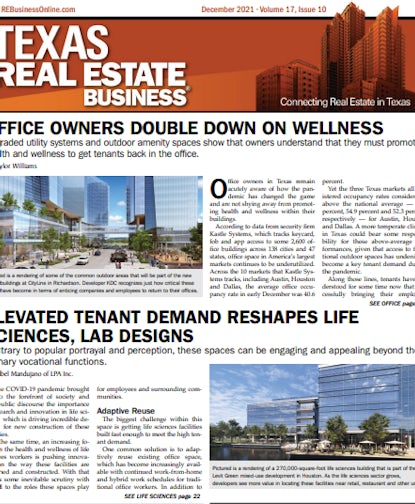By Isabel Mandujano, director of lab planning, LPA Inc.
The COVID-19 pandemic brought to the forefront the importance of research and innovation in life sciences, which is driving incredible demand for new construction of these and laboratory facilities.
At the same time, an increasing focus on the health and wellness of life sciences workers is pushing innovation in the way these facilities are designed and constructed — as well as with regard to the roles these spaces play for employees and surrounding communities.
Adaptive Reuse
The biggest challenge within this space is getting life sciences facilities built fast enough to meet the high tenant demand.
One common solution is to adaptively reuse existing office space, which has become increasingly available with continued work-from-home and hybrid work schedules for traditional office workers. In addition to being a more environmentally friendly solution, this approach shortens project timelines significantly and allows end users to move in and start using the space much more quickly.
The conversion of space that was not originally designed for laboratory use comes with the complex technical challenges of upgrading the required infrastructure and adapting less-than-ideal physical space. An integrated team of architects, designers and engineers is best suited to finding creative solutions to these challenges.
Better Work Experience
Traditionally, people think of laboratories as highly technical, sterile spaces in dark basements. But today’s companies are looking to give their employees better working experiences, recognizing that comfortable environments are key to promoting the creativity and collaboration needed for innovation.
On these projects, we look to incorporate ample daylight, as well as to blend private focus areas and collaboration spaces. We also aim to provide amenities such as all-hands event spaces, access to outdoor areas, break rooms with a café feel and the other benefits of modern offices.
Technology Advancements
The lab planning industry is moving toward more automation and robotics. A modular, adaptable design — one that allows users to easily adjust the space for each new piece of equipment and technology without remodeling — is critical to ensuring laboratories can accommodate the latest technological innovations and best practices.
Computational research and artificial intelligence (AI) will continue to influence the shift from traditional wet labs to spaces that also support data analytics.
Connection to the Community
Particularly in more urban areas, life sciences companies are increasingly welcoming surrounding communities into their spaces. Companies are incorporating areas for events and adding incubators to foster innovation in research and development.
In some cases, Shark Tank-like events with investors and workforce development seminars are hosted in these areas, and students from nearby educational institutions are encouraged to use coworking spaces to study. This utilization of space transforms the stereotype of life sciences facilities as isolated entities in suburban research campuses into vibrant organizations that are woven into the fabric of their communities.
Sustainability
Laboratories use 10 times more energy than other building types. Consequently, it’s incredibly important to implement creative solutions to create more sustainable and efficient laboratory spaces.
The building envelope is an important variable, but there are also many design strategies to consider on the lab operations side by working with lab managers and users to evaluate alternative options.
For example, fume hoods use a sizable amount of energy, and in the United States, the standard is 100 feet per minute face velocity. Energy efficient fume hoods, on the other hand, can run as low as 60 feet per minute. It’s important to work with the engineering team and local regulators to understand the types of chemicals used in the space to determine if lower flow fume hoods can be a viable solution.
Employing point-of-use, rather than central systems, for utilities such as laboratory vacuums and pure water can also afford more flexibility as tenant needs change. The focused systems allow users to provide services where they are really needed, rather than hard piping through the whole building, which lowers efficiency and increases maintenance.
Green chemistry programs, which guide lab users in using chemicals that are less harmful to people and the environment —as well as recycling programs for laboratory supplies — are other important considerations that can be implemented in existing laboratories.
Material Shortages
Supply chain disruptions and material shortages mean that preplanning is more important than ever. Many of the construction and raw materials imported from abroad — metal studs, insulation, stainless steel, glass — are becoming difficult to source. For building developers, this obstacle means that early design decisions must be made before tenants are identified. For designers, this also means getting creative in considering alternative materials in order to maintain project schedules.
Developers should also fuse adaptability and flexibility into the design to avoid expensive rework mid-construction. Involving construction partners early in the design ensures a much smoother process, as long lead items can be identified ahead of the completion of construction documents.
Lab managers are finding similar issues sourcing basic laboratory supplies. Many companies cannot afford to stockpile materials. Facilities that can accommodate just-in-time deliveries and warehousing are highly sought after.















